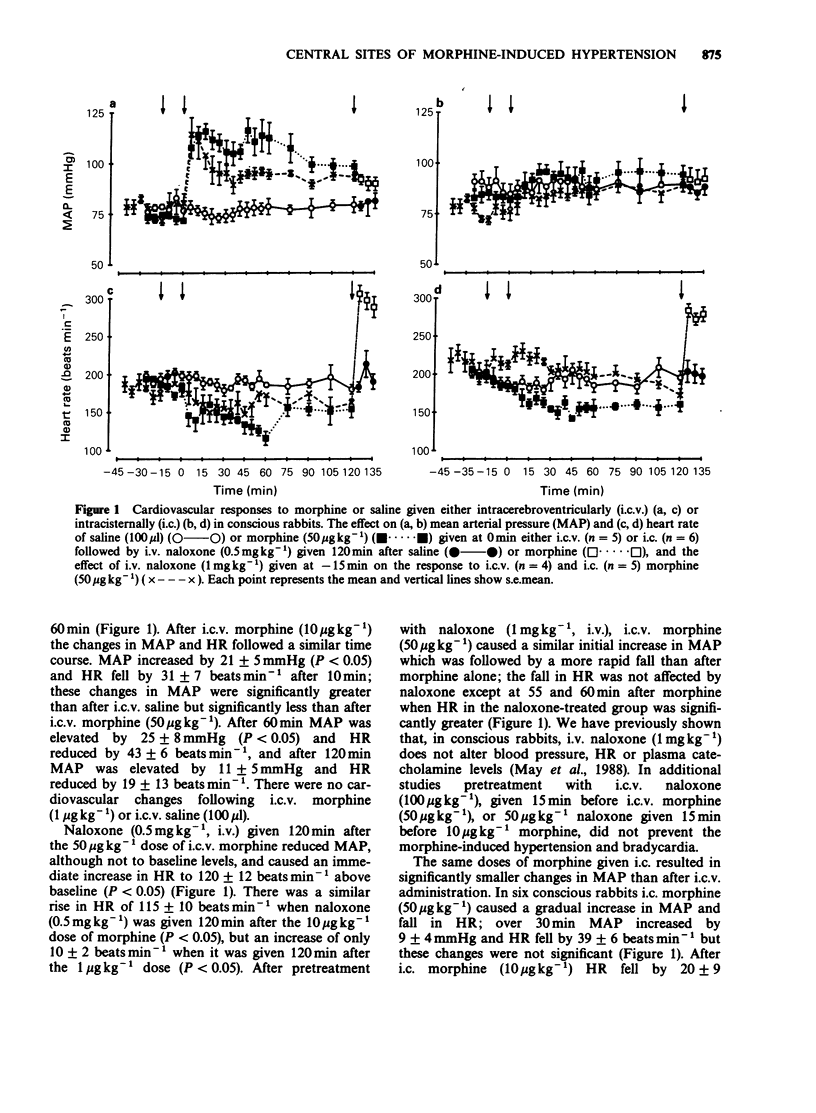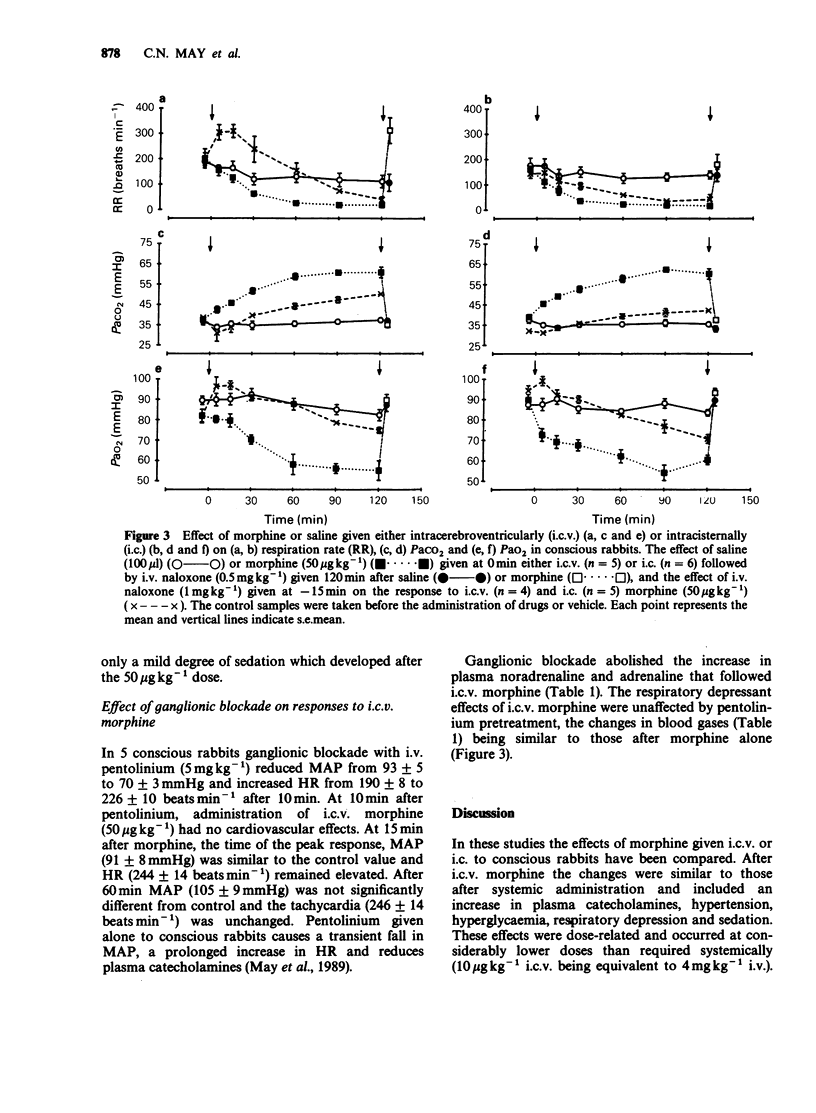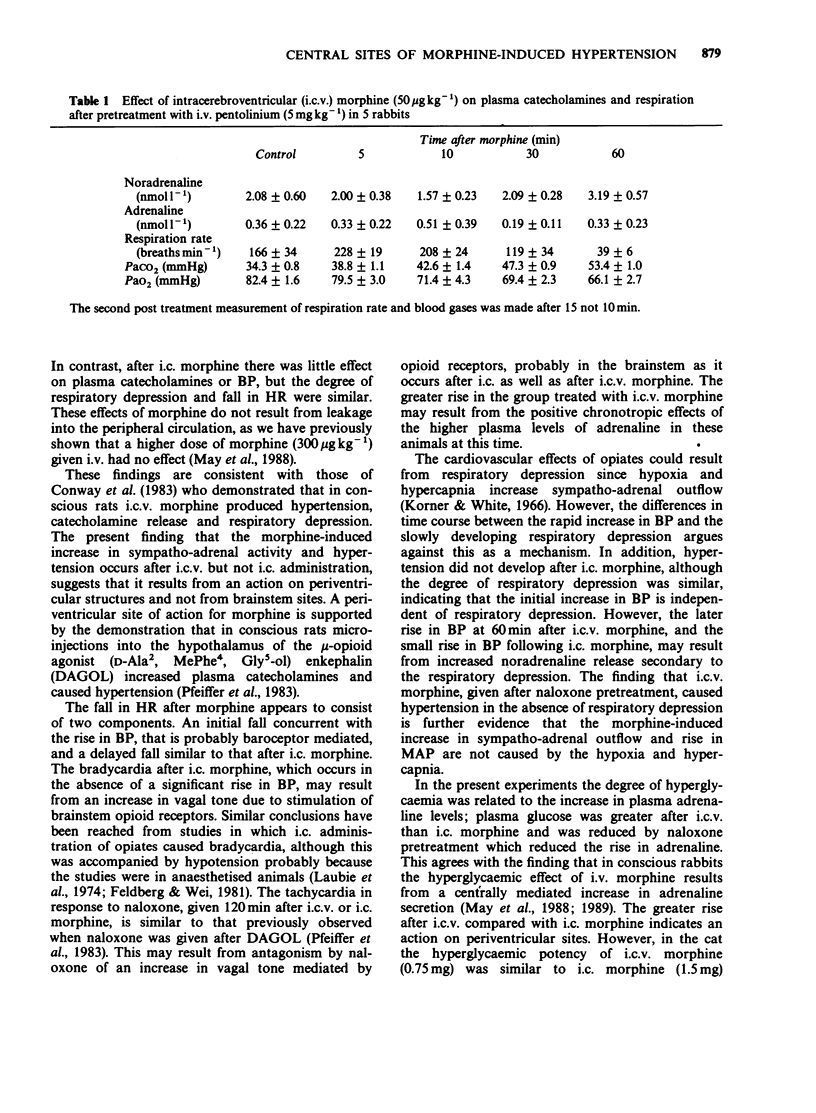Abstract
1. In conscious rabbits intracerebroventricular (i.c.v.) morphine (10 and 50 micrograms kg-1) caused a dose-related increase in plasma noradrenaline and adrenaline, respiratory depression and sedation. The increase in sympatho-adrenal outflow resulted in hypertension accompanied by bradycardia and the increase in adrenaline secretion caused hyperglycaemia. Morphine (1 microgram kg-1 i.c.v.) and i.c.v. saline had no effect. 2. The same doses of morphine given intracisternally (i.c.) caused bradycardia and a similar degree of respiratory depression to i.c.v. morphine, but no significant increase in blood pressure and only a small, gradual rise in plasma adrenaline. 3. Intravenous naloxone (1 mg kg-1) did not block the hypertension, hyperglycaemia or increase in plasma catecholamines that followed i.c.v. morphine, but prevented the respiratory depression and sedation. 4. Ganglionic blockade with pentolinium prevented the rise in plasma catecholamines, blood pressure and plasma glucose induced by i.c.v. morphine. 5. These findings demonstrate that the increased sympathoadrenal outflow following i.c.v. morphine results from an action on periventricular structures. The resultant increase in plasma catecholamines, which is largely naloxone resistant, accounts for the hypertension and hyperglycaemia. The bradycardia is probably partly baroflex mediated and partly due to an increase in vagal tone as a result of stimulation of brainstem opioid receptors. The respiratory depression is probably due to an action of morphine on brainstem opioid receptors.
Full text
PDF








Selected References
These references are in PubMed. This may not be the complete list of references from this article.
- Brown M. R., Fisher L. A. Brain peptide regulation of adrenal epinephrine secretion. Am J Physiol. 1984 Jul;247(1 Pt 1):E41–E46. doi: 10.1152/ajpendo.1984.247.1.E41. [DOI] [PubMed] [Google Scholar]
- Conway E. L., Brown M. J., Dollery C. T. Plasma catecholamine and cardiovascular responses to morphine and D-ala2-d-leu5-enkephalin in conscious rats. Arch Int Pharmacodyn Ther. 1983 Oct;265(2):244–258. [PubMed] [Google Scholar]
- Feldberg W., Pyke D. A., Stubbs W. A. Hyperglycaemia, a morphine-like effect produced by naloxone in the cat. J Physiol. 1983 Jul;340:121–128. doi: 10.1113/jphysiol.1983.sp014753. [DOI] [PMC free article] [PubMed] [Google Scholar]
- Feldberg W., Pyke D., Stubbs W. A. Hyperglycaemia: imitating Claude Bernard's piqûre with drugs. J Auton Nerv Syst. 1985 Nov;14(3):213–228. doi: 10.1016/0165-1838(85)90111-0. [DOI] [PubMed] [Google Scholar]
- Head G. A., Korner P. I., Lewis S. L., Badoer E. Contribution of noradrenergic and serotonergic neurons to the circulatory effects of centrally acting clonidine and alpha-methyldopa in rabbits. J Cardiovasc Pharmacol. 1983 Nov-Dec;5(6):945–953. doi: 10.1097/00005344-198311000-00006. [DOI] [PubMed] [Google Scholar]
- Holaday J. W. Cardiovascular effects of endogenous opiate systems. Annu Rev Pharmacol Toxicol. 1983;23:541–594. doi: 10.1146/annurev.pa.23.040183.002545. [DOI] [PubMed] [Google Scholar]
- Holaday J. W., Faden A. I. Naloxone reversal of endotoxin hypotension suggests role of endorphins in shock. Nature. 1978 Oct 5;275(5679):450–451. doi: 10.1038/275450a0. [DOI] [PubMed] [Google Scholar]
- Korner P. I., White S. W. Circulatory control in hypoxia by the sympathetic nerves and adrenal medulla. J Physiol. 1966 May;184(2):272–290. doi: 10.1113/jphysiol.1966.sp007915. [DOI] [PMC free article] [PubMed] [Google Scholar]
- Laubie M., Schmitt H., Canellas J., Roquebert J., Demichel P. Centrally mediated bradycardia and hypotension induced by narcotic analgesics: dextromoramide and fentanyl. Eur J Pharmacol. 1974 Sep;28(1):66–75. doi: 10.1016/0014-2999(74)90113-7. [DOI] [PubMed] [Google Scholar]
- May C. N., Ham I. W., Heslop K. E., Stone F. A., Mathias C. J. Intravenous morphine causes hypertension, hyperglycaemia and increases sympatho-adrenal outflow in conscious rabbits. Clin Sci (Lond) 1988 Jul;75(1):71–77. doi: 10.1042/cs0750071. [DOI] [PubMed] [Google Scholar]
- May C. N., Whitehead C. J., Heslop K. E., Mathias C. J. Evidence that intravenous morphine stimulates central opiate receptors to increase sympatho-adrenal outflow and cause hypertension in conscious rabbits. Clin Sci (Lond) 1989 Apr;76(4):431–437. doi: 10.1042/cs0760431. [DOI] [PubMed] [Google Scholar]
- Petty M. A., Reid J. L. The effect of opiates on arterial baroreceptor reflex function in the rabbit. Naunyn Schmiedebergs Arch Pharmacol. 1982 Jun;319(3):206–211. doi: 10.1007/BF00495866. [DOI] [PubMed] [Google Scholar]
- Pfeiffer A., Feuerstein G., Zerbe R. L., Faden A. I., Kopin I. J. Mu-receptors mediate opioid cardiovascular effects at anterior hypothalamic sites through sympatho-adrenomedullary and parasympathetic pathways. Endocrinology. 1983 Sep;113(3):929–938. doi: 10.1210/endo-113-3-929. [DOI] [PubMed] [Google Scholar]
- Rutter P. C., Potocnik S. J., Ludbrook J. Sympathoadrenal mechanisms in cardiovascular responses to naloxone after hemorrhage. Am J Physiol. 1987 Jan;252(1 Pt 2):H40–H46. doi: 10.1152/ajpheart.1987.252.1.H40. [DOI] [PubMed] [Google Scholar]


